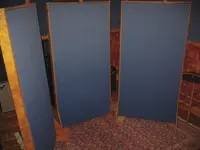O
Olijanovi
New member
Thanks to everyone's advice out here, I just built 8 broadband absorber panels. I was able to make 8 panels in an afternoon with my friend. Now here is the thing:
1- They really do work, it's incredible.
2- Where do I position them? I have a rectangular room.
3- Is there a certain height?
4- Should I put them all between wall and ceiling?
5- Should I build another set of panels in order to create kind of a closed enclosure? Or simply having them on the walls will do the job.
I am mostly wanting to record music (at the moment) less to mix. When I record guitar, I can hear the reflection from the walls. I guess we go project by project. And this one is a recording one, the mixing will be done elsewhere.
1- They really do work, it's incredible.
2- Where do I position them? I have a rectangular room.
3- Is there a certain height?
4- Should I put them all between wall and ceiling?
5- Should I build another set of panels in order to create kind of a closed enclosure? Or simply having them on the walls will do the job.
I am mostly wanting to record music (at the moment) less to mix. When I record guitar, I can hear the reflection from the walls. I guess we go project by project. And this one is a recording one, the mixing will be done elsewhere.


